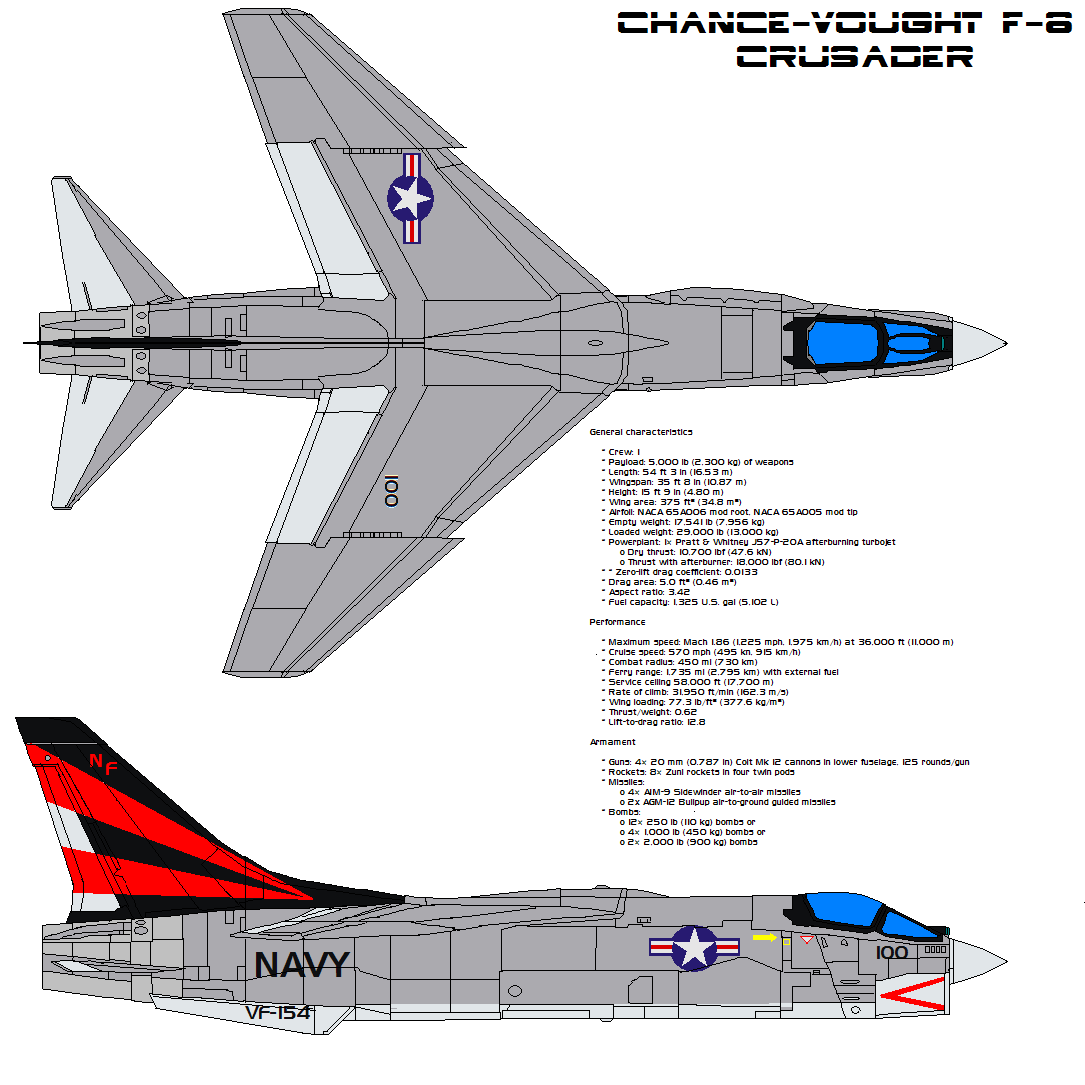HOME | DD
 bagera3005 — Vought F-8 Crusader
by-nc-nd
bagera3005 — Vought F-8 Crusader
by-nc-nd

Published: 2008-06-11 04:01:04 +0000 UTC; Views: 14851; Favourites: 83; Downloads: 2176
Redirect to original
Description
The F-8 Crusader (originally F8U) was a single-engine aircraft carrier-based fighter aircraft built by Chance-Vought of Dallas, Texas, USA. It replaced the Vought F-7 Cutlass. The first F-8 prototype was ready for flight in February 1955, and was the last American fighter with guns as the primary weapon.[1] The RF-8 Crusader was a photo-reconnaissance development and operated longer in U.S. service than any of the fighter versions. RF-8s played a crucial role in the Cuban Missile Crisis, providing essential low-level photographs impossible to acquire by other means.[1] Naval Reserve units continued to operate the RF-8 until 1987.Design and development
In September 1952, United States Navy announced a requirement for a new fighter. It was to have a top speed of Mach 1.2 at 30,000 ft (9,150 m) with a climb rate of 25,000 ft/min (127 m/s), and a landing speed of no more than 100 mph (160 km/h).[2] Korean War experience had demonstrated that 0.50 in (12.7 mm) machine guns were no longer sufficient and as the result the new fighter was to carry a 20 mm (0.8 in) cannon. In response, the Vought team led by John Russell Clark created the V-383. Unusual for a fighter, the aircraft had a high-mounted wing which allowed for short and light landing gear.
The most innovative aspect of the design was the variable-incidence wing which pivoted by 7° out of the fuselage on takeoff and landing. This afforded increased lift due to a greater angle of attack without compromising forward visibility because the fuselage stayed level.[2][1] Simultaneously, the lift was augmented by leading-edge slats drooping by 25° and inboard flaps extending to 30°. The rest of the aircraft took advantage of contemporary aerodynamic innovations with area ruled fuselage, all-moving stabilators, dog-tooth notching at the wing folds for improved yaw stability, and liberal use of titanium in the airframe. Power came from the Pratt & Whitney J57 afterburning turbojet and the armament, as specified by the Navy, consisted of four 20 mm cannon, a retractable tray with 32 unguided Mighty Mouse FFARs, and cheek pylons for two AIM-9 Sidewinder air-to-air missiles.[2] Vought also presented a tactical reconnaissance version of the aircraft called the V-382. The F-8 Crusader would be the last U.S. fighter designed with guns as its primary weapon.[1]
Major competition came from Grumman with the F-11 Tiger, McDonnell with upgraded twin-engine F3H Demon (which would eventually become the F-4 Phantom II), and North American with their F-100 Super Sabre adopted for carrier use and dubbed the Super Fury.
In May 1953, the Vought design was declared a winner and in June, Vought received an order for three XF8U-1 prototypes (after adoption of the unified designation system in September 1962, the F8U became the F-8). The first prototype flew on 25 March 1955 with John Konrad at the controls. The aircraft exceeded the speed of sound during its maiden flight.[1] The development was so trouble-free that the second prototype, along with the first production F8U-1, flew on the same day, 30 September 1955. On 4 April 1956, the F8U-1 performed its first catapult launch from USS Forrestal.
Crusader III
In parallel with the F8U-1s and -2s, the Crusader design team was also working on a larger aircraft with ever greater performance, internally designated as the V-401. Although the XF8U-3 Crusader III was externally similar to the Crusader and sharing with it such design elements as the variable incidence wing, the new fighter was significantly larger and shared few components.
Specifications (F-8E)
General characteristics
* Crew: 1
* Payload: 5,000 lb (2,300 kg) of weapons
* Length: 54 ft 3 in (16.53 m)
* Wingspan: 35 ft 8 in (10.87 m)
* Height: 15 ft 9 in (4.80 m)
* Wing area: 375 ft² (34.8 m²





* Airfoil: NACA 65A006 mod root, NACA 65A005 mod tip
* Empty weight: 17,541 lb (7,956 kg)
* Loaded weight: 29,000 lb (13,000 kg)
* Powerplant: 1× Pratt & Whitney J57-P-20A afterburning turbojet
o Dry thrust: 10,700 lbf (47.6 kN)
o Thrust with afterburner: 18,000 lbf (80.1 kN)
* * Zero-lift drag coefficient: 0.0133
* Drag area: 5.0 ft² (0.46 m²





* Aspect ratio: 3.42
* Fuel capacity: 1,325 U.S. gal (5,102 L)
Performance
* Maximum speed: Mach 1.86 (1,225 mph, 1,975 km/h) at 36,000 ft (11,000 m)
* Cruise speed: 570 mph (495 kn, 915 km/h)
* Combat radius: 450 mi (730 km)
* Ferry range: 1,735 mi (2,795 km) with external fuel
* Service ceiling 58,000 ft (17,700 m)
* Rate of climb: 31,950 ft/min (162.3 m/s)
* Wing loading: 77.3 lb/ft² (377.6 kg/m²





* Thrust/weight: 0.62
* Lift-to-drag ratio: 12.8
Armament
* Guns: 4× 20 mm (0.787 in) Colt Mk 12 cannons in lower fuselage, 125 rounds/gun
* Rockets: 8× Zuni rockets in four twin pods
* Missiles:
o 4× AIM-9 Sidewinder air-to-air missiles
o 2x AGM-12 Bullpup air-to-ground guided missiles
* Bombs:
o 12× 250 lb (110 kg) bombs or
o 4× 1,000 lb (450 kg) bombs or
o 2× 2,000 lb (900 kg) bombs
Related content
Comments: 6

This is by far my most favorite, and the best naval fighter ever built.
👍: 0 ⏩: 0

This planed kicked Vietnamese Commie Ass!!! There's a saying; "When you're out of F-8s your out of fighters!!"
👍: 0 ⏩: 0

Crusader!!
Crusader pilots never feared other aircraft. SAMs, maybe. But never other fighters. That is the legacy of the Crusader.
👍: 0 ⏩: 0

Not bad, althoug during their crusader days, VF-154's tails were the regualr gull gray with white control surfaces, their bloodstripes had more of an slight orange hue, and they bore the tailcode "NL" and modex numbers in 400 range
👍: 0 ⏩: 0
























